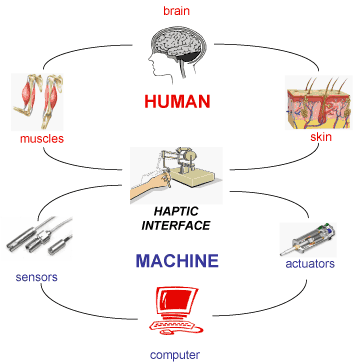 |
||||||
| HOME |
||||||

A virtual environment that truly immerses its users must create the appropriate sensations that suggest presence. Among these sensations the contribution of haptic feedback to sense of realism can be especially important. The process by which virtual objects are made apparent through a manual interface by simulating the feel of touch is called haptic rendering. Our research in this area concentrates on dynamics, systems and controls based approaches for rendering the haptic response of virtual objects. To faithfully represent physical reality three core algorithms are to be implemented simultaneously in real-time, namely, a collision detector, an interaction resolver and a multi-body dynamics simulator. Moreover, these algorithms employ a dynamic, a geometric and an interaction model. The main challenges in haptic rendering research are to improve on these models and algorithms to achieve more realistic simulations. Models and algorithms for rendering systems with changing contact conditions is of special interest since these models are capable of capturing the phenomena that generate arguably the most important (and often most easily perceived) features of human-machine interaction. Our research in haptic rendering concentrates on synthesis of appropriate physically-based models from a systems approach as well as automatic determination of parameters in these models. Furthermore, we investigate design of algorithms with guaranteed stability and robustness properties from a controls perspective. Since we always treat switching as an integral part of analysis, our results are valid even for systems with changing contact conditions. |
 |
|
|
| Patoglu, Volkan Gillespie, R. Brent |
|
| |
|
| The Haptic Probe Extremal Distance Maintenance On-line Symbolic Constraint Embedding |
|
| |
|
| Extremal Distance Maintenance The Haptic Probe Haptic Rendering of Parametric Surfaces Stabilized Minimum Distance Maintenance A Global Closest Point Algorithm On-line Symbolic Constraint Embedding A Closest Point Algorithm with GUAS |
|
| Project Sponsors | |
| National Science Foundation | |